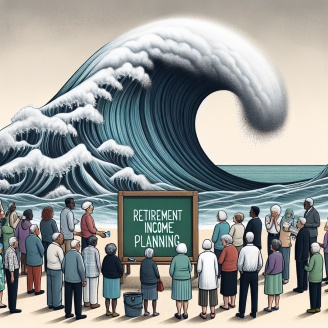The Silver Tsunami & The Pivot To Retirement Income for Consumers
A Silver Tsunami will arrive in a little more than five years, as every Baby Boomer will be over age 65. With that backdrop, the advisory community and their clients face a profound shift, as millions of Americans will need sustainable retirement income strategies that address longevity, inflation, and rising healthcare costs. While traditional retirement planning has focused on accumulation, today’s retirees need solutions that balance withdrawals, tax considerations, and risk management to support their retirement goals.
Yet, even with clarity about this shift, one critical component is often neglected: Long-Term Care (LTC) Planning. Ignoring the potential impact of future LTC needs can unravel even the best income plans, exposing clients and their loved ones to financial stress and reducing legacy goals.
Incorporating Long-Term Care Risk Into The Income Strategy
Instead of viewing LTC as a separate risk category or planning topic, it should be integrated as a component of the retirement income plan because the failure to address LTC likely leaves clients with significant gaps that can drain retirement assets, jeopardize income stability, and compromise family finances. Let's consider the following case study: The Long-Term Care Impact on a 65-Year-Old Couple’s Retirement Income Plan.
Client Profile: Age 65 with $1 million of assets, diversified across retirement accounts, conservative investments, and cash reserves.
The Goal: Maintain financial stability throughout retirement, secure care if needed, and avoid becoming a financial burden to loved ones.
Planning Scenario: The couple’s advisor develops an income plan to maintain their current lifestyle with modest withdrawals and tax-sensitive strategies. They anticipate a 30-year horizon, targeting a sustainable withdrawal rate to avoid depleting their portfolio by age 95.
Projected LTC Need: Based on longevity and health statistics, it’s reasonable to plan for a scenario where one spouse may require LTC in their later years, around age 85. As such, a HALO Assessment or some other predictive modeling for future care needs is necessary to better plan for this eventuality. If the modeling projects a client may need X years of home health care, assisted living or nursing home care expenses, proper planning can be implemented to meet the clients’ needs.
Financial Impact at Age 85: Without a dedicated LTC strategy, the advisor projects that:
- Cost of Care: A five-year LTC need could easily surpass $600,000 in today’s dollars, a significant portion of their total portfolio.
- Portfolio Depletion: Funding LTC out of pocket would require substantial withdrawals, which would threaten income security and potentially exhaust resources within a few years.
- Impact on Surviving Spouse: If one spouse passes, the surviving partner will face limited income and a reduced portfolio, putting their financial stability at risk.
Incorporating LTC into the Retirement Income Plan: For this couple, dedicating part of their portfolio to an LTC solution can create protection against these risks. Options might include:
- Insurance-Based LTC Funding Source: The couple would create and have access to tax-advantaged liquidity if care is needed without jeopardizing income for the surviving spouse.
- Asset-Based LTC Strategies: Allocating a portion of their savings for a hybrid LTC insurance solution ensures funds are available when needed but preserves their assets or legacy if LTC is not needed.
- Viable Self-Funding: Allocating savings to cover at least a portion of potential LTC costs, the couple can avoid unplanned withdrawals and stay on track with their income goals.
By incorporating LTC as an essential variable in retirement income planning, advisors provide clients with greater peace of mind and security through their later years. This planning approach is not just for those with limited resources — high-net-worth and affluent clients, too, benefit from structured LTC planning to protect substantial assets, ensure income stability, and safeguard their legacy goals.
Regardless of one’s financial position, Long-Term Care Planning offers a way to preserve wealth for future generations while minimizing the need for disruptive asset liquidation during a care event. By addressing care needs and asset preservation, clients are better equipped to weather the impact of the Silver Tsunami on the healthcare system, maintaining the financial position they’ve worked hard to build and enhancing the legacy they leave behind.
Shifting the focus to retirement income makes a stronger case for proactive LTC Planning.....
20241030

